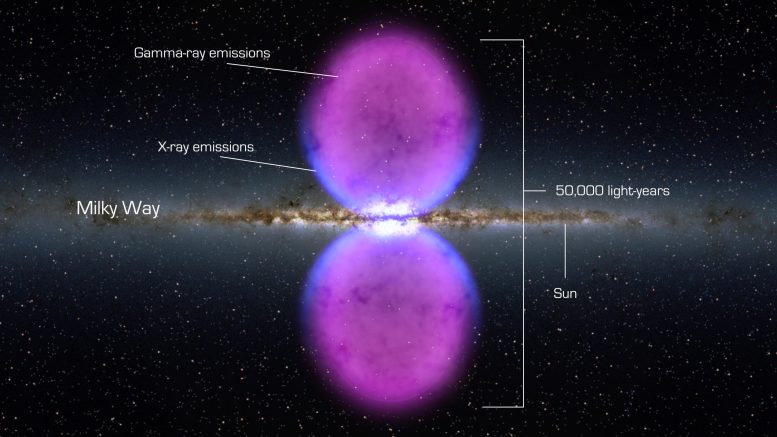
NASA’s Fermi Gamma-Ray Telescope has detected enough energetic photons to produce the first all-sky map of the very high energy universe. Since Fermi’s launch in 2008, it has found almost 500 celestial sources of photons, but about a third of those remain mysteries to researchers.
The human eye is crucial to astronomy. Without the ability to see, the luminous universe of stars, planets, and galaxies would be closed to us, unknown forever. Nevertheless, astronomers cannot shake their fascination with the invisible.
Outside the realm of human vision is an entire electromagnetic spectrum of wonders. Each type of light—from radio waves to gamma rays— reveals something unique about the universe. Some wavelengths are best for studying black holes; others reveal newborn stars and planets; while others illuminate the earliest years of cosmic history.
A new ScienceCast video takes viewers on a trip to the edge of the electromagnetic spectrum, where mysterious objects are puzzling astronomers.
NASA has many telescopes “working the wavelengths” up and down the electromagnetic spectrum. One of them, the Fermi Gamma-Ray Telescope orbiting Earth, has just crossed a new electromagnetic frontier.
“Fermi is picking up crazy-energetic photons,” says Dave Thompson, an astrophysicist at NASA’s Goddard Space Flight Center. “And it’s detecting so many of them we’ve been able to produce the first all-sky map of the very high energy universe.”
“This is what the sky looks like near the very edge of the electromagnetic spectrum, between 10 billion and 100 billion electron volts.”
The light we see with human eyes consists of photons with energies in the range of 2 to 3 electron volts. The gamma rays Fermi detects are billions of times more energetic, from 20 million to more than 300 billion electron volts. These gamma-ray photons are so energetic, they cannot be guided by the mirrors and lenses found in ordinary telescopes. Instead, Fermi uses a sensor that is more like a Geiger counter than a telescope. If we could wear Fermi’s gamma-ray “glasses,” we’d witness powerful bullets of energy – individual gamma rays – from cosmic phenomena such as supermassive black holes and hypernova explosions. The sky would be a frenzy of activity.
Before Fermi was launched in June 2008, there were only four known celestial sources of photons in this energy range. “In 3 years Fermi has found almost 500 more,” says Thompson.
Using data from NASA’s Fermi Gamma-ray Space Telescope, scientists have recently discovered a gigantic, mysterious structure in our galaxy. This feature looks like a pair of bubbles extending above and below our galaxy’s center. Each lobe is 25,000 light-years tall and the whole structure may be only a few million years old. (Video credit: NASA’s Goddard Space Flight Center)
What lies within this new realm?
“Mystery, for one thing,” says Thompson. “About a third of the new sources can’t be clearly linked to any of the known types of objects that produce gamma rays. We have no idea what they are.”
The rest have one thing in common: prodigious energy.
“Among them are super massive black holes called blazars; the seething remnants of supernova explosions; and rapidly rotating neutron stars called pulsars.”
And some of the gamma rays seem to come from the ‘Fermi bubbles’ – giant structures emanating from the Milky Way’s center and spanning some 20,000 light-years above and below the galactic plane.
Exactly how these bubbles formed is another mystery.
Now that the first sky map is complete, Fermi is working on another, more sensitive and detailed survey.
“In the next few years, Fermi should reveal something new about all of these phenomena, what makes them tick, and why they generate such ‘unearthly’ levels of energy,” says David Paneque, a leader in this work from the Max Planck Institute in Germany.
For now, though, there are more unknowns than knowns about “Fermi’s world.”
Says Thompson: “It’s pretty exciting!”
Never miss a breakthrough: Join the SciTechDaily newsletter.